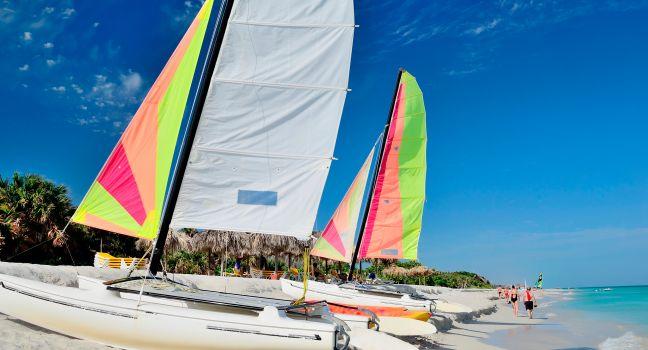Varadero

Depending on your travel tastes, Varadero could be a tropical, care-free paradise or mass tourist inferno. It's Cuba's most popular tourist destination, for two good reasons: Playa Azul, a spectacular, stretch of white-sand beach; and the all-inclusive resorts that rival those of similar resort areas anywhere in the world (and remove all the logistical stresses of traveling independently in Cuba). Varadero is also a good base for catamaran cruises, sport fishing, and excursions to Matanzas, Cárdenas, and the Península de Zapata. Although most of the hotels are managed by foreign companies, they all offer basically the same tours operated by Cuban-owned tour operators,
This narrow peninsula—really an elongated island separated from the mainland by the Laguna Paso Malo—is just over 20 km (12 miles) long and is edged by seemingly endless, white-sand beaches and clear waters in mesmerizing blues, greens, and aquamarines. You can almost walk the beach from one end to the other, but there are a few rocky sections. At an average width of 700 meters (770 yards), Varadero extends northeast to Punta Hicacos, Cuba's northernmost point. Laid out in three longitudinal avenues intersected by 69 cross streets, Varadero town is easy to navigate. It's a warren of more than 50 hotels, plus restaurants, shops, and nightclubs.
Originally inhabited by the Taíno, Varadero was settled by the Spanish in the late 16th century. In the late 19th century, families from Cárdenas began to build summer houses here. In 1883 the first town council established a plan for building baths and recreational facilities. The Varadero Hotel opened in 1915, and in 1926 the du Pont de Nemours family—the powerful American industrialists whose early fortune was made in gunpowder—bought most of the peninsula and built a large estate complete with a golf course. Other wealthy norteamericanos followed, including Al Capone.
By the 1950s, numerous hotels were under construction; they followed the example of the Hotel Internacional, a quintessential den of iniquity complete with a casino, mobsters, and abundant available women. After 1959, the Revolution declared the elitist enclave public property, and rank-and-file Cubans were allowed on the beach. Varadero then became a favorite Russian resort, where Eastern European tourists frolicked in the sun and guzzled mojitos right under Uncle Sam's nose. Today it's favored by Europeans and Canadians, attracted by reasonable prices for all-inclusive beach holidays ranging from affordable, midrange family hotels to pricey, superluxurious spa resorts. More hotel complexes are currently under construction, filling the few available sites left.
Recommended Fodor's Video
Elsewhere in Varadero
Cardenas >
Restaurants (1), Things to do (3), Hotels (0)
Cayo Largo >
Restaurants (1), Things to do (1), Hotels (2)
Cayo Levisa >
Restaurants (0), Things to do (0), Hotels (1)
Isla de la Juventud >
Restaurants (0), Things to do (0), Hotels (0)




